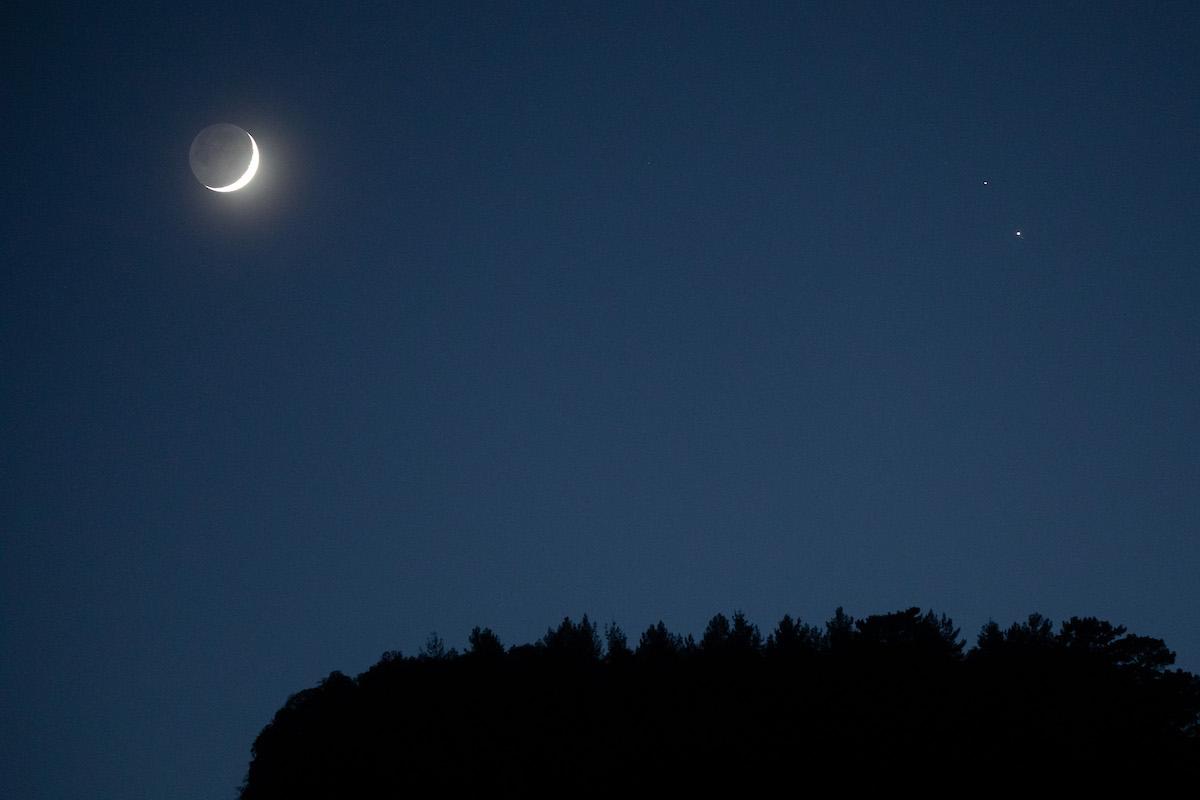How to See the First “Christmas Star” in 800 Years As Jupiter and Saturn Align
Jupiter and Saturn are about to pass each other by this closely for the first time in 800 years, resulting in a "Christmas Star."
Published Dec. 21 2020, 12:19 p.m. ET

The waxing crescent moon and the planets Saturn and Jupiter are shown above a windmill at Western Trails Park on Nov. 19, 2020 in Las Vegas.
Without a doubt, the most exciting thing you’ll see looking up at the sky this week is Santa Claus and his reindeer. But the No. 2 most exciting celestial phenomenon gracing the night sky this holiday season is the Christmas Star, as it will be the first humans have seen in 800 years.
Read on to find out exactly what the December 2020 Christmas Star is, the best time to see the Christmas Star (which happens to fall on the same day as the winter solstice), and how Jupiter and Saturn play into the heavenly event.
After all, the conjunction is the subject of the Dec. 21 Google Doodle, so you know it’s worth checking out.

A crescent moon (L) is seen with Saturn (upper right) and Jupiter (lower right) ahead of their closest visible conjunction on Dec. 17, 2020 in Antalya, Turkey.
What is the Christmas Star? Jupiter and Saturn’s alignment make it possible.
Even though it’s called the Christmas Star, the astronomical event is actually not a star at all. Rather, it’s a planetary conjunction that happens when Jupiter and Saturn align in the sky. As these two planets are very bright — and the largest ones in the solar system — their alignment results in what looks like a bright star.
“You can imagine the solar system to be a racetrack, with each of the planets as a runner in their own lane and the Earth toward the center of the stadium,” Henry Throop, a NASA astronomer, explained in a statement. “From our vantage point, we’ll be able to see Jupiter on the inside lane, approaching Saturn all month and finally overtaking it on Dec. 21.”
As NASA explains, Jupiter and Saturn align in the sky once every 20 years or so — but this year is different, as it’s the first time in 800 years where this alignment will occur this closely and at night. Therefore, people across the globe will be able to see it take place. The last time Jupiter and Saturn passed each other this closely was 400 years ago, but it happened during the day, so it wasn’t as visible.
Jupiter and Saturn will appear just inches apart from those of us on Earth — but according to NASA, the planets will still be hundreds of millions of miles apart in outer space.
When is the best time to see the Christmas star?
The best time to see the Christmas Star is on the evening of Dec. 21, 2020, within the hour following your local sunset. You need to find the sweet spot of when the sky is completely dark, but before Jupiter and Saturn set — and this should apply no matter where you are on Earth.
"On December 21, the sun will set around 4:30. After that, it is a race — the sky must get dark enough to see Jupiter and Saturn before they set as well, around 6:45," Walter Freeman, a physics professor at Syracuse University, told CNN, referring to Eastern Time. “Jupiter and Saturn will likely stand out from the twilight glow starting around 5:00 or 5:15.”
But if the evening of Dec. 21 doesn’t work for you, fear not: the Christmas Star is technically viewable for about two weeks, every evening from Dec. 15, 2020 until the end of the month, though Dec. 21 will be the best night to see it clearly.
How to see the Christmas Star:
Here are NASA’s best tips for seeing the Christmas Star.
- Go to a wide open space with an unobstructed view of the night sky.
- You should be able to see the Christmas Star with your naked eyes, but with the help of binoculars or a telescope, you might spot Jupiter’s four moons orbiting the planet as well.
- Let Elphaba’s warning “if you care to find me, look to the western sky!” serve as a reminder of where to look tonight. But OK, technically, NASA recommends looking to the southwestern sky — and remember, do so within the hour after sunset.
- Here’s what to look for: what appears as a bright, easily visible star — that’s Jupiter. Just above it to the left, you’ll see Saturn, though it will be a bit fainter than Jupiter. But on Dec. 21, the two planets will reverse positions in the sky — so if you’re Christmas Star-spotting after the winter solstice just reverse those coordinates.